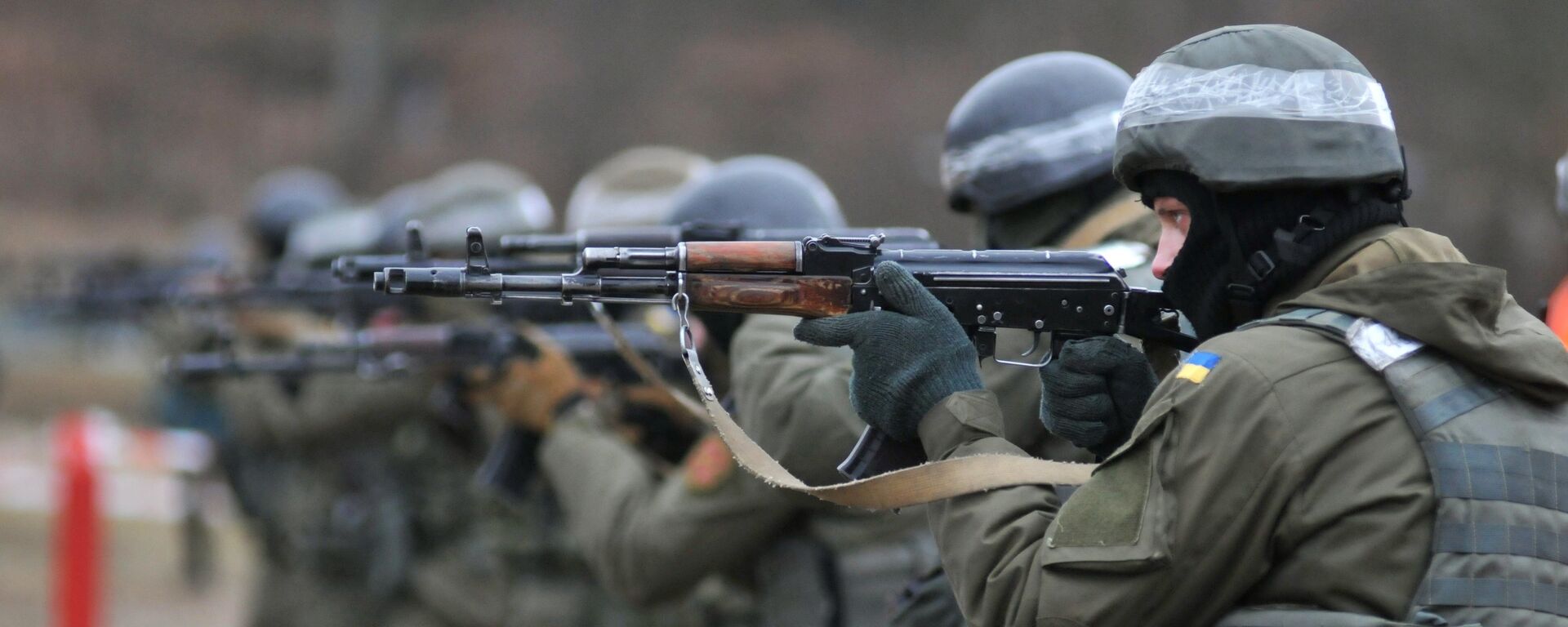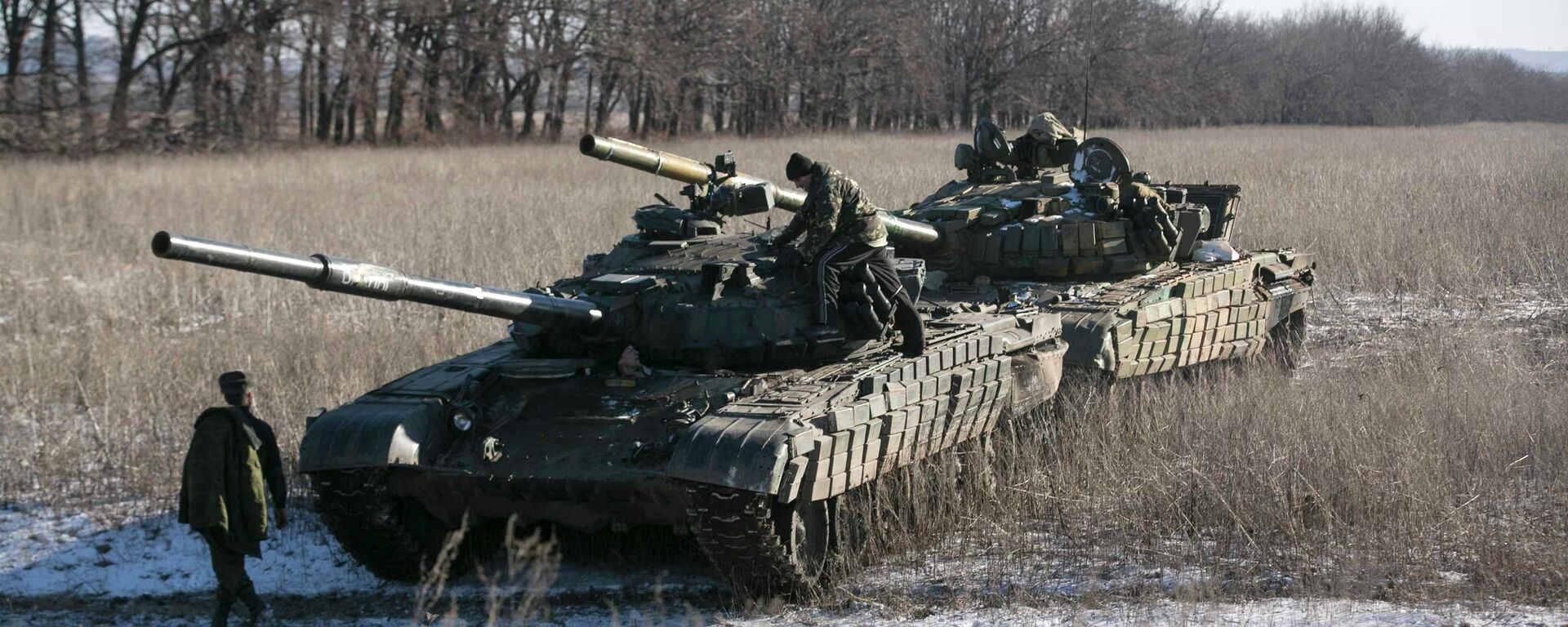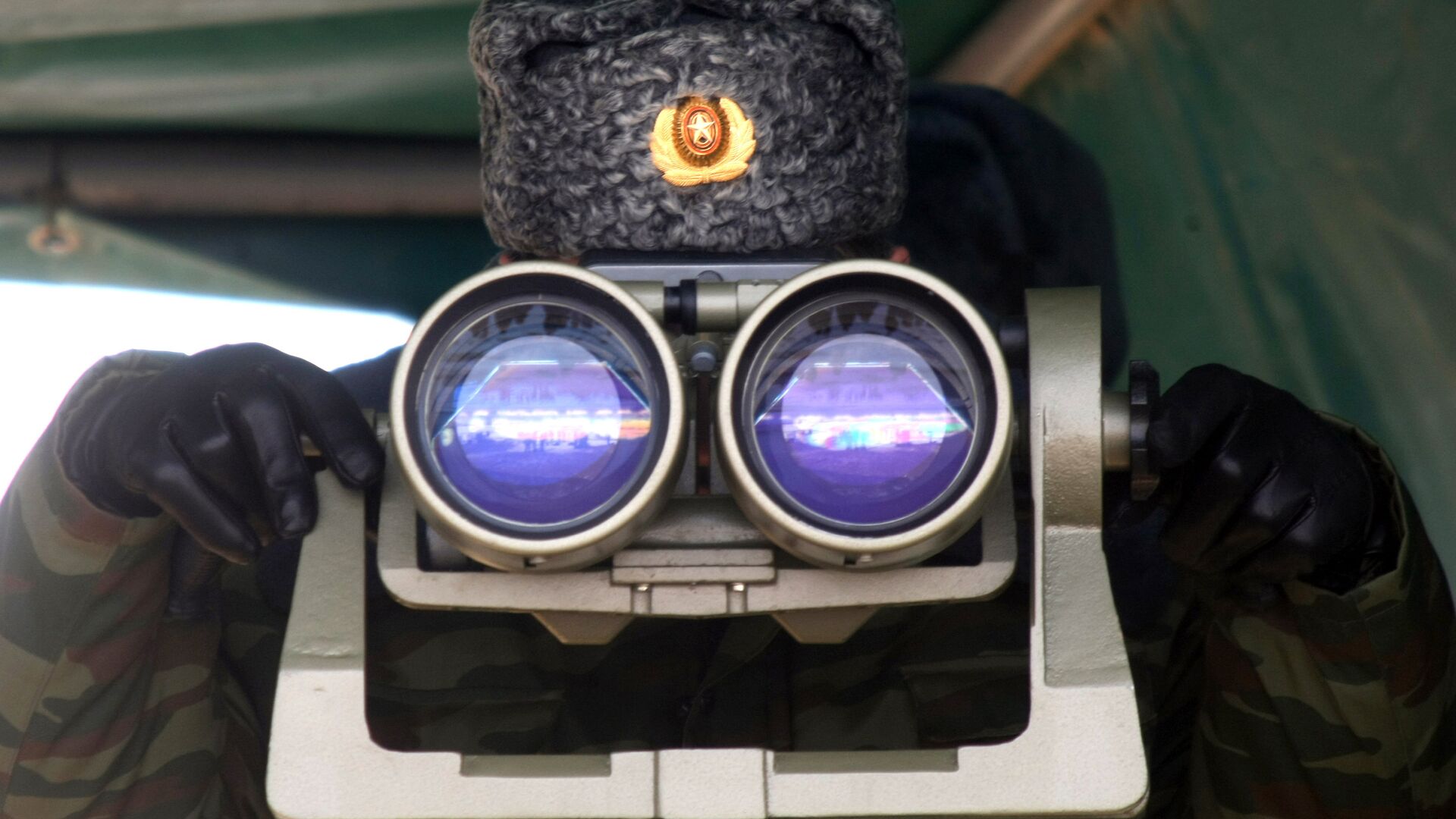https://sputnikglobe.com/20211115/stoltenberg-says-no-consensus-for-ukraine-to-join-nato-warns-russia-against-aggressive-actions-1090750629.html
Stoltenberg Says No Consensus for Ukraine to Join NATO, Warns Russia Against ‘Aggressive Actions’
Stoltenberg Says No Consensus for Ukraine to Join NATO, Warns Russia Against ‘Aggressive Actions’
Sputnik International
Western officials and media have accused Russia of engaging in a military buildup on the border with Ukraine but have yet to present any evidence to that... 15.11.2021, Sputnik International
2021-11-15T13:34+0000
2021-11-15T13:34+0000
2021-11-15T18:36+0000
russia
ukraine
jens stoltenberg
nato
https://cdn1.img.sputnikglobe.com/img/106710/68/1067106873_0:160:3073:1888_1920x0_80_0_0_66fbcecbd03b9b03b055d5fabe767534.jpg
NATO Secretary-General Jens Stoltenberg has reiterated recent alliance claims about a supposed Russian “buildup” near the Ukrainian frontier, making the comments less than 24 hours after admitting that there was no consensus in the alliance on accepting Kiev into the US-led military bloc.“We have just discussed the security situation in and around Ukraine. In recent weeks we have seen large and unusual concentrations of Russian forces close to Ukraine’s borders,” Stoltenberg said, speaking alongside Ukrainian Foreign Minister Dmytro Kuleba in NATO headquarters on Monday.Stoltenberg stressed that NATO would continue to provide “political and practical support” to Ukraine, including training assistance, and claimed that recent NATO drills in the Black Sea were “defensive and transparent,” and “not a threat to Russia.”The secretary-general’s comments follow remarks Sunday in which he admitted that although the bloc’s partnership with Kiev was getting “closer,” there was “no consensus” among allies for the politically unstable country to join the alliance.“I know that [Ukrainian President Volodymyr Zelensky] wants something more and I respect that he appreciates the support he gets from NATO allies, but he also has been very clear when I meet him that he wants something more – he wants full membership,” Stoltenberg said, speaking to Axios in a dicey interview with a neocon interviewer seeking to push him into “defending” Kiev against Russia.Is Ukraine Eligible?Under NATO rules, applicants must resolve any ethnic disputes, external territorial disputes, irredentist claims or internal jurisdictional disputes in accordance with Organisation for Security Cooperation in Europe principles before they can join. Under these rules, Ukraine cannot become a member of the alliance until it ends the civil war in the country’s east, stops any threats against its Russian-speaking population, and resolve the conflict with Russia over Crimea – the Black Sea Peninsula which split off from Kiev’s control and rejoined Russia in March 2014 in the aftermath of a US- and EU-backed coup in Kiev.The US and its allies accused Russia of a military buildup near Ukraine in the spring of 2021, amid reports that Kiev was considering a military operation to take back its rebellious eastern regions by force.Fresh claims of a Russian buildup began to spread in early November after Politico published satellite photos purporting to show the assembly of Russian armoured equipment “on the border with Ukraine,” but actually showing images of vehicles and support equipment in Yelnya, Smolensk region, about 250 km north of Ukraine, and even further from the conflict zone in Ukraine’s east.Moscow dismissed the “buildup” claims as “fake news” and said it was none of NATO’s business where Russia manoeuvres troops inside its own territory.On 2 November, in a rare note of apparent agreement with Russia, Oleksiy Danilov, secretary of Ukraine’s National Security and Defence Council, dismissed Politico’s reporting as “deliberate misinformation” and said it was “not clear to us why [US media was] doing this.” In a follow-up, the Ukrainian Defence Ministry’s Main Intelligence Directorate similarly indicated that no additional Russian units, weapons or military equipment had been observed being transferred to the border area.Russia has expressed serious anxiety about NATO’s continual expansion toward its borders. Over 30 years ago in 1990, US Secretary of State James Baker promised Soviet Secretary General Mikhail Gorbachev that the Western alliance would not expand beyond the borders of a reunified Germany following the German Democratic Republic’s annexation by Bonn. In the decades since, the alliance has swallowed up all five members of the former Warsaw Pact alliance (including Czechoslovakia, which split into two countries), plus the three Baltic republics of the former Soviet Union, and four republics of the former Yugoslavia – which NATO bombed repeatedly throughout the 1990s.At every turn, the bloc emphasised that its expansion "poses no threat to Russia," while simultaneously rejecting Russian inquiries about joining the alliance in the mid-1990s and early 2000s. Since 2014 and the Ukrainian crisis, NATO has beefed up its military contingents in Eastern Europe and deployed Aegis Ashore missile defence facilities in Romania and Poland. Russian officials have expressed concern that Aegis Ashore’s launchers could easily be converted to fire conventional or nuclear-tipped Tomahawk cruise missiles at targets inside Russia – with a flight time to Moscow from these sites of less than two minutes –less than half that of the Pershing and cruise missiles stationed by the US in Western Europe in the early 1980s.
https://sputnikglobe.com/20211021/putin-calls-nato-military-presence-in-ukraine-a-real-threat-to-russia-1090108239.html
https://sputnikglobe.com/20211114/us-media-reveal-why-nato-arms-aid-to-ukraine-risks-crossing-a-bright-red-line-with-russia-1090729310.html
ukraine
Sputnik International
feedback@sputniknews.com
+74956456601
MIA „Rossiya Segodnya“
2021
News
en_EN
Sputnik International
feedback@sputniknews.com
+74956456601
MIA „Rossiya Segodnya“
Sputnik International
feedback@sputniknews.com
+74956456601
MIA „Rossiya Segodnya“
ukraine, jens stoltenberg, nato
ukraine, jens stoltenberg, nato
Stoltenberg Says No Consensus for Ukraine to Join NATO, Warns Russia Against ‘Aggressive Actions’
13:34 GMT 15.11.2021 (Updated: 18:36 GMT 15.11.2021) Western officials and media have accused Russia of engaging in a military buildup on the border with Ukraine but have yet to present any evidence to that effect apart from satellite photos of Russian ground forces situated over 250 km to the country’s north, and some 800 km from the frozen civil conflict in Ukraine’s east.
NATO Secretary-General Jens Stoltenberg has reiterated recent alliance claims about a supposed Russian “buildup” near the Ukrainian frontier, making the comments less than 24 hours after admitting that there was no consensus in the alliance on accepting Kiev into the US-led military bloc.
“We have just discussed the security situation in and around Ukraine. In recent weeks we have seen large and unusual concentrations of Russian forces close to Ukraine’s borders,” Stoltenberg
said, speaking alongside Ukrainian Foreign Minister Dmytro Kuleba in NATO headquarters on Monday.
“We are monitoring the situation very closely, and we continue to consult among allies and partners such as Ukraine and the European Union. Any further provocation or aggressive actions by Russia would be of serious concern. We call on Russia to be transparent about its military activities,” the official added, stressing that the Western bloc “stands with” Ukraine, and calling on Moscow to end its alleged “support” for militias in the de-facto self-ruled regions of eastern Ukraine.
Stoltenberg stressed that NATO would continue to provide “political and practical support” to Ukraine, including training assistance, and claimed that recent NATO drills in the Black Sea were “defensive and transparent,” and “not a threat to Russia.”
The secretary-general’s comments follow remarks Sunday in which he admitted that although the bloc’s partnership with Kiev was getting “closer,” there was “no consensus” among allies for the politically unstable country to join the alliance.
“I know that [Ukrainian President Volodymyr Zelensky] wants something more and I respect that he appreciates the support he gets from NATO allies, but he also has been very clear when I meet him that he wants something more – he wants full membership,” Stoltenberg
said, speaking to Axios in a dicey interview with a neocon interviewer seeking to push him into “defending” Kiev against Russia.
“Ukraine is not part of NATO, meaning Ukraine is not covered by our collective defence clause, Article 5. To be a NATO member, you need to meet the NATO standards. We helped them with modernising, fighting corruption, but thirty allies have to agree and we don’t have a consensus agreement with NATO on inviting Ukraine into becoming a full member,” Stoltenberg explained.
Under
NATO rules, applicants must resolve any ethnic disputes, external territorial disputes, irredentist claims or internal jurisdictional disputes in accordance with Organisation for Security Cooperation in Europe principles before they can join. Under these rules, Ukraine cannot become a member of the alliance until it ends the civil war in the country’s east, stops any threats against its Russian-speaking population, and resolve the conflict with Russia over Crimea – the Black Sea Peninsula which split off from Kiev’s control and rejoined Russia in March 2014 in the aftermath of a US- and EU-backed coup in Kiev.
The US and its allies accused Russia of a military buildup near Ukraine in the spring of 2021, amid reports that Kiev was considering a military operation to take back its rebellious eastern regions by force.
Fresh claims of a Russian buildup began to spread in early November after Politico
published satellite photos purporting to show the assembly of Russian armoured equipment “on the border with Ukraine,” but actually showing images of vehicles and support equipment in Yelnya, Smolensk region, about 250 km north of Ukraine, and even further from the conflict zone in Ukraine’s east.
Moscow dismissed the “buildup” claims as “fake news” and said it was none of NATO’s business where Russia manoeuvres troops inside its own territory.
On 2 November, in a rare note of apparent agreement with Russia, Oleksiy Danilov, secretary of Ukraine’s National Security and Defence Council,
dismissed Politico’s reporting as “deliberate misinformation” and said it was “not clear to us why [US media was] doing this.” In a follow-up, the Ukrainian Defence Ministry’s Main Intelligence Directorate similarly indicated that no additional Russian units, weapons or military equipment had been observed being transferred to the border area.

21 October 2021, 16:41 GMT
Russia has expressed serious anxiety about NATO’s continual expansion toward its borders. Over 30 years ago in 1990, US Secretary of State James Baker promised Soviet Secretary General Mikhail Gorbachev that the Western alliance would not expand beyond the borders of a reunified Germany following the German Democratic Republic’s annexation by Bonn. In the decades since, the alliance has swallowed up all five members of the former Warsaw Pact alliance (including Czechoslovakia, which split into two countries), plus the three Baltic republics of the former Soviet Union, and four republics of the former Yugoslavia – which NATO bombed repeatedly throughout the 1990s.
At every turn, the bloc emphasised that its expansion "poses no threat to Russia," while simultaneously rejecting Russian inquiries about joining the alliance in the mid-1990s and early 2000s. Since 2014 and the Ukrainian crisis, NATO has beefed up its military contingents in Eastern Europe and deployed Aegis Ashore missile defence facilities in Romania and Poland. Russian officials have expressed concern that Aegis Ashore’s launchers could easily be converted to fire conventional or nuclear-tipped Tomahawk cruise missiles at targets inside Russia – with a flight time to Moscow from these sites of less than two minutes –less than half that of the Pershing and cruise missiles stationed by the US in Western Europe in the early 1980s.

14 November 2021, 15:35 GMT




